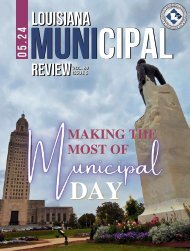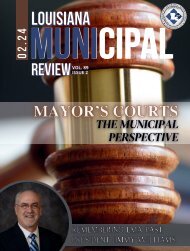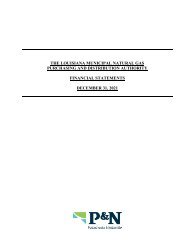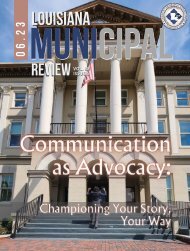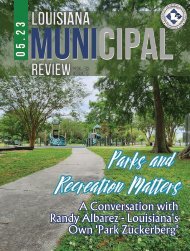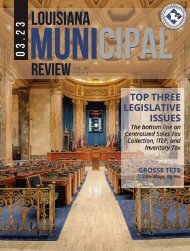LMR JULY 2020
July 2020 Louisiana Municipal Review
July 2020 Louisiana Municipal Review
Create successful ePaper yourself
Turn your PDF publications into a flip-book with our unique Google optimized e-Paper software.
Introduction to Safely Reopening
Municipal Facilities
The closures to stem the spread of the
novel coronavirus (COVID-19) have
been devastating to local economies of
all sizes, with a projected nationwide
loss of $360 Billion in city revenues
over the next three years. Vulnerable
communities – Black, Indigenous, and People of Color
(BIPOC), and people with low-incomes – are seeing
the harshest fallout in financial instability, sickness and
deaths.
Municipalities are faced with the challenge of deciding
when and how to reopen their economies.
Balancing public health, economic and workforce
priorities is vital but complicated. Wait too long and
risk even more harm to the economy. Move too soon
and get an uptick in cases and deaths causing further
damage to the local economy, as well as residents’
mental and physical wellbeing.
Important Consideration on Reopening Your City,
Town or Village
To reopen cities, towns, and villages with measured
confidence in the absence of a safe and effective
vaccine that is widely administered, the path forward
must have the following checkpoints in concurring
order:
1. Fourteen (14) consecutive days of reductions in
positive cases and hospitalizations;
2. Widespread testing to diagnose COVID-19 and track
status of spread across populations;
3. Robust contact tracing to identify, trace and safely
isolate people who are infected;
4. Sufficient health care capacity in personnel, facilities
and equipment to treat those sick with COVID-19; and
5. Sufficient PPEs for all essential workers required for
city operations, and for all workers going back to work.
The decision to reopen needs to be informed by data
and be appropriate for local culture and context. As
cities open in stages, the checkpoints above are vital
to balancing continued mitigation and moving to
containment. In light of many unknowns regarding the
spread of the novel virus and its impact on people of all
ages, a more conservative approach is prudent. Cities
without sufficient capacity to test all residents will
want to prioritize testing, tracing, access to healthcare
and outreach to those who are most at risk: essential
workers of all skill- and income-levels, people in nursing
homes, people in prison, BIPOC, people
in low-income communities and the
elderly writ large.
Communication is Key
There are signs of progress and
reductions in transmission and death
rates in hot spots of the U.S. but progress will be a long
and difficult process until a vaccine is developed and
safely administered. Cities must find a “new normal,”
where residents can get back to work, to do things
they enjoy in a different way than pre-COVID days –
this means sacrificing certain amenities to do things
more safely than before, in order to minimize viral
transmissions.
Local leaders can instill a sense of community and
shared responsibility, and prevent complacency. As
cities, towns and villages reopen their economy in a
landscape of uncertainty, local officials bring credibility
and relationships that can strengthen public confidence
and support a range of actions to increase safety:
- Be transparent about the spread of infections
and illnesses – stay on top of the evolving spread
and potential need to take action to rachet up safe
distancing.
- Work with contiguous cities/counties to coordinate
actions and communications whenever possible.
Consistency in guidance helps reinforce guidelines
and keep people safe while emerging from their
homes.
- Work with local health department, state and
regional partners for sufficient testing and contact
tracing. Notify city residents about the availability
of testing and loosening guidelines for who can get
tests if additional testing capacity is now available.
• Ensure the data software and management of
tracing is built with an equity lens.
• Build community confidence in contract tracing,
and ensure honesty, accountability, and transparency
about the process.
- Prioritize vulnerable communities – people who
lack access to testing and good care, and who
live or work in places with high risk of infections.
These areas of greatest need include essential
workers, nursing homes, and neighborhoods with
a high concentration of people of color.
SEE REOPENING PAGE 24
Page 18
LMR | JULY 2020



